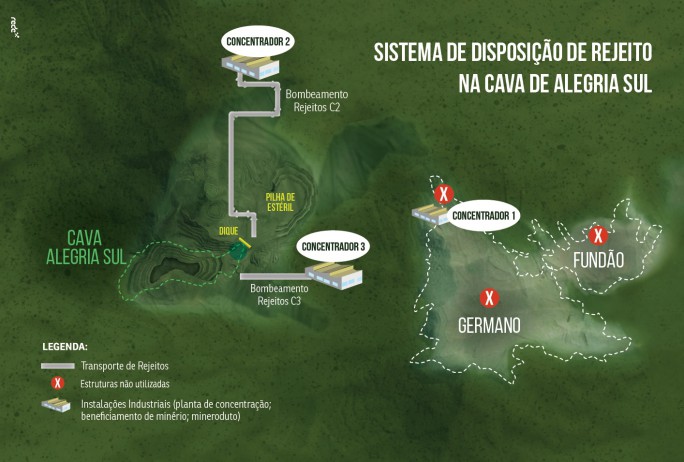14/12/2016

The new tailings disposal system using the Alegria Sul mine pit, proposed in the licensing process which has been submitted to SEMAD (the Minas Gerais State Environmental Agency), is one of the steps in the operational planning of Samarco. Located in Ouro Preto, MG, within the Germano-Alegria Industrial Unit, the structure provides operational safety as it uses a confined area, thus not requiring the construction of a dam similar to Fundão, which failed on 05 November 2015.
The Alegria Sul pit is a temporary alternative that will allow tailings disposal upon the future resumption of operations at 60% of production capacity. At that rate, the Company will be able to generate sufficient revenue to maintain jobs and contribute to the development of the economies of the States of Minas Gerais and Espírito Santo, and the country as a whole.
The disposal of tailings in the pit has the approval of the National Department of Mineral Production (DNPM), an autonomous government agency subordinated to the Ministry of Mines and Energy. According to the technical note issued by this entity on 21 November of this year, “the proposed solution is extremely safe, as it represents disposal in a pit allowing the confinement of the tailings”.
In addition to using an already existing pit, the structure will also have a 10 meter high dike made of compacted soil, providing a total storage capacity of 17 million cubic meters of tailings. This will assure a horizon of about two years for Samarco operations.
See below how the pit will be filled:

In adition to the pit disposal project, Samarco is intensifying its studies to find alternatives for the medium and long range. The options being analyzed refer to structures already available and environmentally impacted in the region of the Germano unit, employing new tailings treatment technologies.
First phase
The licensing of the Alegria Sul pit for tailings disposal is one of the phases of Samarco’s operational planning. However, it is not sufficient to allow the Company to resume its operations. For that it still needs the Corrective Operational License (LOC) which will bring together all of the structures within the Germano Complex under one single environmental license. The LOC was requested by SEMAD to assure the environmental feasibility of the project.
Should Samarco get the necessary license approval, its operational planning involves a first phase of operation at 60% capacity, producing 18 million tons of pellets per year. In the Integrated Economic Development Plan filed with the DNPM, the Company estimates a production of about 36.7 million tons of ore in the first two years.
Currently, the Company has 2.86 billion tons of ore reserves in the Germano complex, in Mariana and Ouro Preto. This volume and the transportation infrastructure represented by its three pipelines plus the four pellet plants in Espírito Santo provide the necessary conditions for Samarco to continue operating competitively on the international market, if it obtains the approval of the environmental entities.
Economic importance
The Company has been inactive for over 12 months, since the failure of the dam. With the delay in the resumption of Samarco’s operations, involving a loss of R$ 4.4 billion of direct and indirect revenue in the Company’s production chain in 2017 – an amount corresponding to 1% of the GDP of the state of Minas Gerais – the government fails to obtain a tax revenue of R$ 989 million, among federal, state and municipal levies.
This total, projected for 2017, represents almost double the amount of all public expenses of the municipalities of Mariana (MG), Ouro Preto (MG), Anchieta (ES) and Guarapari (ES) related to health, education, sanitation and transportation. The numbers are in the report developed by Tendências Consultoria Integrada.
Samarco also had to reduce its work force, dismissing 924 employees through a Voluntary Dismissal Plan, and 153 in an Involuntary Dismissal Plan.
The study made by Tendências Consultoria Integrada concluded that the Company’s continued shutdown will place at risk almost 20 thousand direct and indirect jobs. Minas Gerais will be the most affected state, with a potential impact of 14,531 job opportunities, and Espírito Santo may lose 4,111 potential jobs.
Without these jobs, the study showed that the loss of income mass in one year may reach R$ 1.2 billion, an amount which represents 4.6% of the Bolsa Familia budget in 2016. The study also shows that, in the long run, the loss of accumulated income mass will reach R$ 13 billion in ten years.